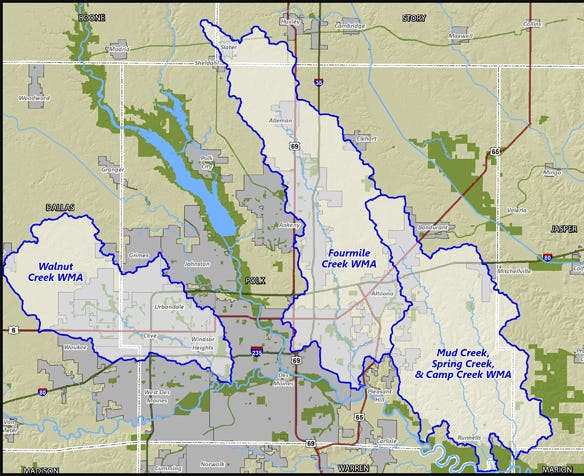May 6, 2021

Iowa Secretary of Agriculture Mike Naig and several public and private conservation partners recently announced a new water quality blitz project. The project will add 40 saturated buffers and 11 bioreactors to farm fields in Polk and Dallas counties, Iowa, to protect water quality and support recreational opportunities in the Des Moines and Raccoon rivers. The first phase of the project should be completed by mid-2022.
Public-private partnerships are an important component to many conservation projects across the state, but this one is unique because of the number of federal, state, county and local governments collaborating. The groups are using a streamlined approach to work with landowners and contractors to get a large number of edge-of-field practices on the ground faster than using the traditional approach. Instead of working on one site at a time, the Polk County Board of Supervisors has hired one contractor to build dozens of bioreactors and saturated buffers on multiple farms.
Collaborative effort
“This project is proof that when we work together to leverage our financial and technical resources, we can get more practices on the ground and do it at a faster rate than ever before,” Naig says. “This project model is being replicated in other priority watersheds around the state. It is a great example of the types of locally driven, community-based conservation projects that we can implement because of significant long-term funding from the state."

PHASE 1 WATERSHEDS: This is a map of the Phase 1 central Iowa blitz project watersheds. (Source: cleanwateriowa.org)

The Iowa Department of Agriculture and Land Stewardship (IDALS) and the Polk County Board of Supervisors are covering the construction costs of the project. IDALS, the Polk County Board of Supervisors and many other partners are providing ongoing technical support.
“If COVID taught us anything, it was the value of outdoor recreation, and our community is taking that to heart by investing in creating a world-class water trails system,” says Angela Connolly, Polk County Board of Supervisors chair. “But recreation initiatives like this don't happen without investments in water quality, and we are seeing tremendous momentum with projects like the saturated buffers, and interest in water quality initiatives from all corners of our community.”
USDA's National Resources Conservation Service provided engineering and design support for the project. The Polk and Dallas Soil and Water Conservation Districts (SWCD), Agricultural Drainage Management Coalition and Hands on Excavating are providing construction, technical and project management support.
Phase 2 adds new sites
While Phase 1 is in motion, project partners are surveying 100 additional sites in Polk, Story and Dallas counties that can be constructed during Phase 2.
“For this project, we really wanted to make things easy for the landowner, both financially and from a workload standpoint. The project focuses on bioreactors and saturated buffers, and we selected which of those practices would be best for each site based on many factors evaluated in the survey process, including tile depth, tile grade, drainage area, soil types, etc. We did this to ensure we treat as much water as possible, while preventing any negative impacts on the field and crops that could be caused by oversaturation of the soil,” says Tanner Puls, Water Quality Initiative coordinator, Polk SWCD. "The project will be installing practices on 51 tile outlets this year, and we have already surveyed over 100 outlets in preparation for another round of installations next year.
“USDA NRCS is committed to helping improve water quality in Iowa by helping farmers implement nutrient-reducing conservation practices like bioreactors and saturated buffers,” says Jon Hubbert, NRCS state conservationist in Iowa. “Major projects like this one in Polk County don’t get accomplished without multiple conservation partners stepping up to do their part.”
“The Agricultural Drainage Management Coalition believes that conservation drainage practices serve a critical role in conservation within working landscapes,” says Keegan Kult, executive director, Agricultural Drainage Management Coalition. “We see the Polk County saturated buffer project as the next step of building capacity to be able to deliver these practices at scale. While we are thrilled with the results the partners were able to accomplish, we are more excited to see how this project can serve as a springboard to continue to move from demonstration to widespread adoption.”
“Hands On Tiling and Excavating is excited to partner with this great group to bring this project to completion,” says Jacob Handsaker, owner of Hands on Excavating. “These practices serve as a great spoke in the wheel of our conservation and water quality goals. The public-private partnership between federal, state and local agencies and private landowners will be a great stepping stone to ease concerns from landowners for the adoption of future water quality and drainage projects.”
Source: Iowa Department of Agriculture and Land Stewardship, which is responsible for the information provided and is wholly owned by the source. Informa Business Media and its subsidiaries aren't responsible for any of the content contained in this information asset.
You May Also Like




